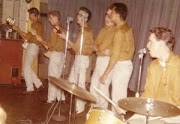Terrific article on New Orleans Music and Burial Customs . Go to the link and listen to the story .

EnlargePat Jolly/APErnie K-Doe poses outside his Mother-In-Law Lounge during Jazz Fest in New Orleans in 2001. He died a few months later and was buried in St. Louis Cemetery No. 2.
Most of the tombs now have a similar design: On top, there's space for a wooden coffin or two, and at the bottom lies a potpourri of decanted family remains. Sooner or later, whoever is up high must vacate and settle lower, making room for the newly dead. That's how families stay together — in a desiccated jumble of grandpas, grandmas, siblings and cousins.
Well, in one of the city's oldest cemeteries, the final resting place of a white, aristocratic New Orleans family is also the eternal home of black musical royalty: an emperor, a king, a consort and a mother-in-law.
From Chitlin' Circuit To Pop Charts
In 1961, Ernie K-Doe managed something that no one from New Orleans had ever done before — not Fats Domino, not Louis Prima, not even Louis Armstrong at that point. K-Doe scored a No. 1 pop hit with a song about his — and apparently a lot of other people's — mother-in-law:
She's the worst person I knowWritten by the New Orleans impresario Allen Toussaint, "Mother-in-Law" is still irresistibly sing-able.
Mother-in-Law, Mother-in-law!
She worries me so
Mother-in-Law, Mother-in-Law!
If she'd leave us alone
We'd have a happy home
Sent from down below
Mother-in-Law. Mother-in-Law!
" 'Mother-in-Law' was No. 1 on the R&B charts for five weeks," says Ben Sandmel, who wrote Ernie K-Doe, The R&B Emperor of New Orleans. "It was No. 1 on the pop charts for one week. This is when the black and white music worlds were considered to be very separate. And he went from playing the Chitlin' Circuit and being a local artist to having huge success in a very short time."

EnlargeCourtesy of Rob Florence Antoinette K-Doe (second from the left) stands with friends around a statue of her deceased husband, Ernie, at the St. Louis No. 2 tomb. Antoinette is buried in the tomb, and her mother — Ernie K-Doe's second and favorite mother-in-law, Leola Clark — is shown in the portrait. Clark is buried in the tomb, too.Courtesy of Rob Florence
K-Doe maintained that only three songs would stand the test of time: "Amazing Grace," "The Star-Spangled Banner" and "Mother-in-Law," because, as he put it, "There's gonna be mothers-in-law until the end of time."
"He was young, he was in great shape ... did all the microphone tricks and the dance moves that had been made famous by James Brown and Jackie Wilson. And he would take whatever material was put in front of him and just sing the hell out of it," he says.
But to most who knew him, Ernie K-Doe had a problem with self-esteem: He had too much of it. He even challenged James Brown to a showdown in New Orleans. Later, K-Doe declared himself "Emperor of the Universe."
St. Louis Cemetery No. 2
Ernie K-Doe never returned to the top of the charts. Instead, he hit bottom, facing alcoholism and homelessness. But in the late 1990s, K-Doe and his wife, Antoinette, opened a club and had a growing cult of young followers.
Then on July 5, 2001, Ernie K-Doe surprised nearly everyone when he died of cancer.
"I was hugging and kissing on Antoinette and doing the typical thing, 'What are you going to do? Where are you going to bury him?' " says Anna Ross, a champion of cemetery preservation in New Orleans, who paid a call on K-Doe's widow when he passed away.
"And she said, well, they have a family cemetery in Erwinville, and he didn't want to be buried there. They have a couple of plots at this cemetery on Airline Highway; he didn't want to be buried there. He really wanted to be buried in St. Louis No. 2, because it was down the street from the bar."

Masahiro Sumori/WikimediaEarl King on stage at the 1997 New Orleans Jazz & Heritage Festival. He died a few years after Ernie K-Doe, and now the two share a tomb.
"Then there was this gossip running around town: 'What is this white woman and her daughter and Antoinette doing? They burying a black man in a white man's tomb,' " Ross says. "My daughter thought it was the right thing to do. So we went ahead and had a funeral. People were dancing on top of tombs and vaults around here. It was wild."
The funeral was as grand as the Emperor had hoped. Thousands came to see Ernie K-Doe's services at the city's most regal hall. The second line parade to the cemetery was so long, it shut down the central business district. And sure enough, K-Doe's coffin desegregated the Twichell family tomb.
"He's the one who's made such a great impact on New Orleans ... and our music," Twichell says. "It's a gift."
Ernie's second mother-in-law — Antoinette's mother — joined him in the tomb shortly thereafter. He liked her. A couple of years later, Twichell opened the door again and welcomed a King.
'Those Lonely, Lonely Nights'
Ernie K-Doe may have had a national No. 1 hit, but Earl King was by far the greater artist. By the time of his death — on April 17, 2003 — King had written briefcases full of blues and R&B standards, including this one:
Those lonely, lonely Nights.Johnny Guitar Watson, Robert Palmer and Teena Marie were among the many who recorded Earl King songs. As was Jimi Hendrix. Remember "Come On (Part 1)"?
There's been some lonely, lonely nights
Oh baby, yes, since you've been gone
Lay my head on my pillow
How I cry all night long
The things you used to say to me
I thought that we would never part
Yes, you know I love you darling
Why did you break my heart?
People see me but they just don't knowAnd then there's the Mardi Gras anthem that King wrote for his mother, "Big Chief." If you ever go to New Orleans and don't hear "Big Chief," then you should ask for your money back, because somebody took you to the wrong town.
What's in my heart and why I love you so
I love ya baby like a miner love gold
So come on baby, let the good times roll
"I'd rank Earl King at the very top in importance of anybody we ever recorded," says Hammond Scott, who was a co-owner of Blacktop Records and recorded King in his later years. "He was one of the most unique songwriters that came out of New Orleans and that ever will. He was dynamite."












No comments:
Post a Comment